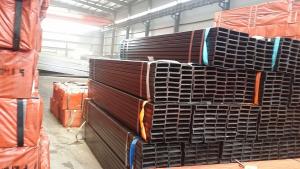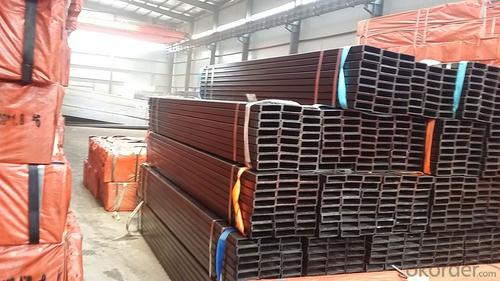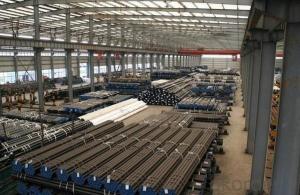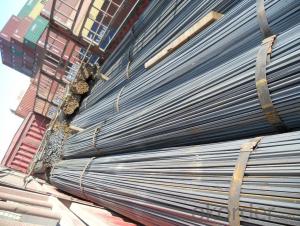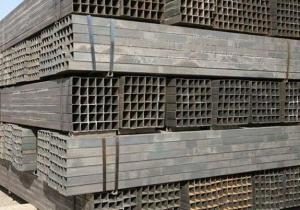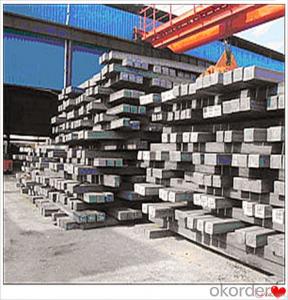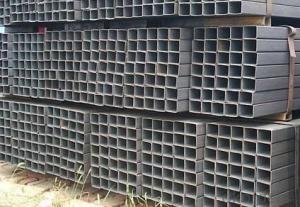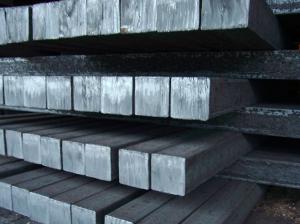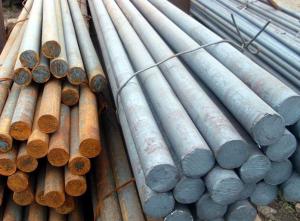Square rectangular tube for building structure Q235/Q345
- Loading Port:
- Tianjin
- Payment Terms:
- TT or LC
- Min Order Qty:
- 20 m.t.
- Supply Capability:
- 1000 m.t./month
OKorder Service Pledge
OKorder Financial Service
You Might Also Like
1、Structure of Square rectangular tube for building structure Q235/Q345 :
Square tube, square tube is a kind of call and rectangular tube, is equal and not equal to the length of steel pipe. Is the strip through the process of processing roll system. In general is the strip through the demolition of the package, flat, curly, welded to form a circular tube, and then rolled into a square tube and then cut into a square tube and then cut into the required length.
2、Main Features of Square rectangular tube for building structure Q235/Q345 :
• Small inertia resistance
• Strong heat dissipation ability
• Good visual effect
• Reasonable price
3、Square rectangular tube for building structure Q235/Q345 Specification:
Standard | GB, DIN, ASTM |
Grade | 10#-45#, 16Mn 10#, 20#, 45#, 16Mn |
Thickness | 1.5 - 25 mm |
Section Shape | Square and rectangular |
Outer Diameter | 20*20 mm-------400*400mm 20*30mm*300*500mm |
Place of Origin | Tianjin, China (Mainland) |
Length | 3-12M |
Outer Diameter | 20*20 mm-------400*400mm 20*30mm*300*500mm |
Grade | 235B 345B |
Standard | ASME, ASTM |
1) Material:(ASTM A 106/A53 GRB.API5LGRB,GB,235B,345B
2) Specification range:OD: 20*30mm----300*500mm 20*20 mm---400*400mm ,WT: 1.5 - 25 mm ,length:3-12m or according to the requirement of clients.
3) Excutive standards:GB,ASME API5L.ASTM A 106/A53,Despite of the above
4) Surface:black lacquered,varnish coating or galvanized.
4、Packaging & Delivery
Packaging Details: | seaworthy package,bundles wrapped with strong steel strip |
Delivery Detail: | 15-30days after received 30%TT |
5、FAQ of Square rectangular tube for building structure Q235/Q345 :
①How is the quality of your products?
Our products are manufactured strictly according to national and internaional standard, and we take a test
on every pipe before delivered out. If you want see our quality certifications and all kinds of testing report, please just ask us for it.
Guaranteed: If products’ quality don’t accord to discription as we give or the promise before you place order, we promise 100% refund.
②How about price?
Yes, we are factory and be able to give you lowest price below market one, and we have a policy that “ for saving time and absolutely honest business attitude, we quote as lowest as possible for any customer, and discount can be given according to quantity”,if you like bargain and factory price is not low enough as you think, just don’t waste your time.Please trust the quotation we would give you, it is professional one.
6、Square rectangular tube for building structure Q235/Q345 Images:
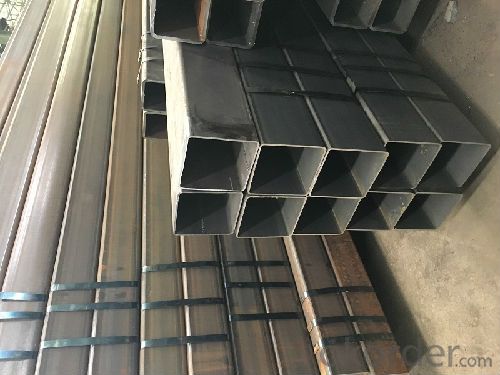
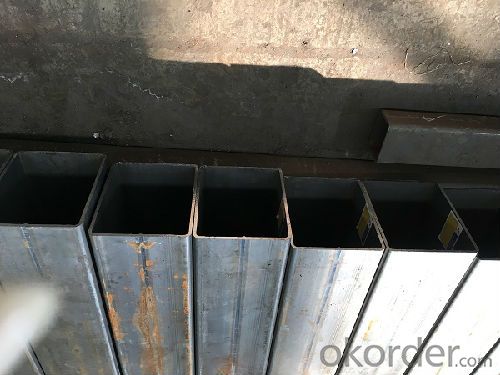
- Q: How are steel pipes used in mining?
- Steel pipes find extensive use in mining operations for a range of purposes. In mining, one of the primary applications of steel pipes involves the transportation of materials, including water, slurry, and other liquids. These pipes possess exceptional durability and can withstand the harsh conditions typically encountered in mining environments, rendering them highly suitable for long-distance material conveyance. Furthermore, steel pipes serve as crucial components in mining ventilation systems. The provision of fresh air to workers and the elimination of harmful gases and dust are of paramount importance in the mining industry. Steel pipes are employed in the construction of ventilation shafts and ducts, facilitating the airflow throughout the mine and ensuring the safety of the miners in their working environment. Moreover, steel pipes contribute significantly to the construction of underground tunnels and mine shafts. By providing structural support and reinforcement, they effectively prevent collapses and maintain the stability of the mine. The strength and durability inherent in steel pipes make them the ideal choice for these critical applications in mining. Another noteworthy use of steel pipes in mining is for the extraction of resources. In certain instances, steel pipes are deployed to establish boreholes or wells, enabling access to underground deposits of minerals or water. Inserted into the ground, these pipes are instrumental in employing various techniques such as drilling or hydraulic fracturing to extract the desired resources. In summary, steel pipes play an indispensable role in the mining industry, serving an array of purposes, including material transportation, ventilation, structural support, and resource extraction. Their strength, durability, and ability to withstand adverse conditions make them an indispensable asset in mining operations.
- Q: ASME seamless tube how to express, what is the form, I did not find on the ASME, thank God!
- Welded and seamless pipe standards are ASME B31.10, no go, if you want to force a seamless tube, the request can be seamless for seamless meaning.In addition to that, the cost and difficulty of manufacturing welded pipe is higher than that of seamless tube.
- Q: What are the different strategies for pipe laying using steel pipes?
- There are several strategies for pipe laying using steel pipes, each suited for different environments and requirements. Here are some of the commonly used strategies: 1. Open Trench: This is the most traditional and widely used method, where a trench is dug along the desired pipeline route. Steel pipes are then laid in the trench, aligned, and welded together. This method allows for easy access, maintenance, and repair of the pipeline. 2. Direct Pipe: This method is used when there are crossings under obstacles such as rivers or highways. It involves drilling a borehole from one side to the other, while simultaneously laying the steel pipe. The pipe is then pulled through the borehole, creating a continuous pipeline. 3. Horizontal Directional Drilling (HDD): HDD is employed when the pipeline needs to be installed under existing infrastructure or environmentally sensitive areas. A pilot hole is drilled horizontally, and the steel pipe is then pulled through the hole using a reaming tool. This technique minimizes disruption to the surface and reduces environmental impact. 4. Sliplining: Sliplining involves inserting a smaller diameter steel pipe into an existing larger pipe. The smaller pipe is pushed or pulled into the larger pipe, providing a new corrosion-resistant lining. This method is commonly used for rehabilitating deteriorated or damaged pipelines. 5. Microtunneling: Microtunneling is similar to HDD, but it involves a microtunnel boring machine (MTBM) that excavates the soil and installs the steel pipe simultaneously. This method is often used for precision pipe laying, especially in urban areas with limited space. 6. Jacking: Jacking, also known as pipe jacking or pipe ramming, is utilized for installing steel pipes in soil conditions that are not suitable for open trenching. This method involves pushing the steel pipe into the ground using hydraulic jacks or pneumatic rams. It is commonly used for crossing under railways, roads, or buildings. 7. Offshore Pipeline Laying: For subsea applications, steel pipes can be laid using a variety of techniques, such as S-lay, J-lay, or reel-lay. These methods involve deploying the pipeline from a vessel, either vertically or at an inclined angle, and welding the steel pipes together as they are lowered to the seabed. Each of these strategies has its own advantages and considerations, depending on factors such as terrain, environmental impact, existing infrastructure, and project requirements. It is important to carefully evaluate these factors and select the most suitable pipe laying strategy to ensure the safe and efficient installation of steel pipes.
- Q: SC15 what does galvanized steel pipe look like?
- DN15 galvanized pipe, nominal diameter of 15mm
- Q: Can steel pipes be used for conveying abrasive materials?
- Yes, steel pipes can be used for conveying abrasive materials. Steel pipes are known for their durability and resistance to wear, making them suitable for handling abrasive materials. Additionally, steel pipes can be lined with various protective coatings or linings to further enhance their resistance to abrasion and extend their lifespan.
- Q: What is the difference between cast iron and steel pipes?
- Cast iron pipes and steel pipes are commonly used in plumbing and construction, but they have distinct differences. Let's explore these disparities. 1. Composition: Cast iron pipes consist mainly of an iron alloy, with small amounts of carbon and other elements. Conversely, steel pipes are primarily composed of iron, but they also contain varying amounts of carbon and other alloying elements like manganese, chromium, and nickel. 2. Strength: Steel pipes generally surpass cast iron pipes in strength due to their higher carbon content and alloying elements. This makes steel pipes more suitable for high-pressure applications or areas with heavy loads. 3. Flexibility: Compared to cast iron pipes, steel pipes offer more flexibility, making installation and adjustment easier. Cast iron pipes, being brittle, are less flexible and more prone to cracking or breaking under excessive stress or impact. 4. Corrosion resistance: Steel pipes are usually more prone to corrosion than cast iron pipes. However, this can be mitigated with various protective coatings or treatments applied to the steel pipes. Cast iron pipes, on the other hand, possess inherent corrosion resistance due to the formation of a protective layer of rust on their surface. 5. Noise insulation: Cast iron pipes excel in noise insulation due to their dense and heavy composition. This makes them ideal for reducing noise in residential plumbing systems. Steel pipes, being lighter and less dense, do not offer the same level of noise insulation. 6. Longevity: When properly maintained, cast iron pipes have a lifespan of over 100 years. Steel pipes, while still durable, may have a shorter lifespan depending on factors like the quality of the steel used, environmental conditions, and maintenance practices. In conclusion, the primary differences between cast iron and steel pipes lie in their composition, strength, flexibility, corrosion resistance, noise insulation, and longevity. The choice between the two depends on specific requirements, such as desired strength, durability, and noise reduction properties.
- Q: What steel pipes are buried for outdoor heating pipes? Seamless or welded tube? Are there any rules for specific countries? Can use the seamed tube?
- Screw on the line, mainly anti-corrosion and insulation, seamless pipe caliber restrictions, so the price is high, with the most affordable screw can meet the requirements, 377 and 273 of the spiral 3920 yuan / ton, straight seam is about 4350
- Q: What are the different methods of welding steel pipes?
- There are several different methods of welding steel pipes, including shielded metal arc welding (SMAW), gas tungsten arc welding (GTAW), gas metal arc welding (GMAW), flux-cored arc welding (FCAW), and submerged arc welding (SAW). Each method has its own advantages and is used depending on factors such as the thickness of the pipes, the type of steel being welded, and the desired outcome.
- Q: How do you calculate the thermal expansion of steel pipes?
- In order to determine the thermal expansion of steel pipes, it is necessary to utilize the coefficient of thermal expansion (CTE) specific to steel. The CTE represents the extent to which a material expands or contracts in response to temperature fluctuations. Typically, the average value of CTE for steel is around 12 x 10^-6 per degree Celsius (12 μm/m°C). To calculate the thermal expansion of a steel pipe, one must possess knowledge of the pipe's initial length (L0), the temperature change (ΔT), and the CTE for steel. The formula for calculating thermal expansion is as follows: ΔL = L0 * CTE * ΔT In this equation: ΔL denotes the alteration in length of the steel pipe L0 represents the initial length of the steel pipe CTE signifies the coefficient of thermal expansion for steel ΔT indicates the change in temperature For instance, suppose there is a steel pipe with an initial length of 2 meters (L0), and the temperature rises by 50 degrees Celsius (ΔT). The CTE for steel is 12 x 10^-6 per degree Celsius. ΔL = 2m * 12 x 10^-6/°C * 50°C ΔL = 0.00024m/m°C * 50°C ΔL = 0.012m Thus, when the temperature increases by 50 degrees Celsius, the steel pipe will expand by 0.012 meters or 12 millimeters. It is important to bear in mind that this calculation assumes linear expansion, which is applicable for minor temperature variations. However, for larger temperature differences or more intricate pipe systems, a more comprehensive analysis may be necessary to consider factors such as the material properties, geometry, and thermal boundary conditions of the pipes.
- Q: How are steel pipes marked for identification?
- Steel pipes are marked for identification through a process called pipe marking. This involves applying labels or markers on the surface of the pipes to provide relevant information about their specifications and characteristics. The markings typically include details such as the pipe's size, grade, material composition, manufacturer's logo or name, and any other relevant codes or standards. These markings are crucial for identification and help ensure that the correct pipes are used for specific applications, as well as for maintenance and repair purposes. Additionally, the markings also aid in quality control and traceability, enabling easy identification and tracking of pipes throughout their lifecycle. Overall, proper identification of steel pipes through clear and durable marking systems is essential for maintaining safety, efficiency, and compliance in various industries where these pipes are utilized.
Send your message to us
Square rectangular tube for building structure Q235/Q345
- Loading Port:
- Tianjin
- Payment Terms:
- TT or LC
- Min Order Qty:
- 20 m.t.
- Supply Capability:
- 1000 m.t./month
OKorder Service Pledge
OKorder Financial Service
Similar products
Hot products
Hot Searches
Related keywords
